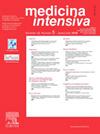静脉注射受体阻滞剂与胺碘酮对成人脓毒症患者住院死亡率和安全性的影响
IF 3.1
4区 医学
Q2 CRITICAL CARE MEDICINE
引用次数: 0
摘要
目的比较乙型受体阻滞剂和胺碘酮在脓毒症合并新发心房颤动(NOAF)患者中的住院死亡率和安全性。原假设:β受体阻滞剂(BBs)与胺碘酮治疗脓毒症患者NOAF的住院死亡率和安全性无显著差异。我们基于MIMIC-IV数据库进行回顾性分析。对脓毒性NOAF患者进行筛查。背景:脓毒症合并NOAF患者入住成人混合ICU。患者共筛选34,789例患者,其中1394例纳入分析:胺碘酮组286例,BBs组1108例。干预措施:主要感兴趣的变量采用cox比例风险模型检查接受胺碘酮或静脉注射BBs的患者的住院死亡率、无呼吸机天数和房颤持续时间。使用倾向评分匹配来确定任何关联。结果倾向评分(PS)匹配后,BB组和胺碘酮组共纳入244例患者。在这个队列中,BBs与较低的住院死亡率显著相关[校正危险比(HR)为0.70](95% CI 0,54 - 0,91; = 0.008页)]。另一方面,接受胺碘酮治疗的患者房颤持续时间较短(54.17 h vs 72.81 h; = 0.003页)。BB组与胺碘酮组无呼吸机天数差异无统计学意义。结论在脓毒症NOAF患者中,服用BBs的患者住院死亡率低于服用胺碘酮的患者。胺碘酮组房颤持续时间较短。BB组与胺碘酮组无呼吸机天数差异无统计学意义。本文章由计算机程序翻译,如有差异,请以英文原文为准。
Intravenous beta-blockers versus amiodarone on in-hospital mortality and safety profile in adult septic patients
Objective
In the present study, we aimed to compare in-hospital mortality and safety of intravenous beta-blockers and amiodarone in septic patients with new-onset atrial fibrillation (NOAF). The null hypothesis is that there is no significant difference in in-hospital mortality and safety of Beta-blocker (BBs) and amiodarone in treating NOAF in patients with sepsis.
Design
We conducted a retrospective analysis based on the MIMIC-IV database. Septic patients with NOAF were screened.
Setting
Patients admitted to adult mixed ICU for septic patients with NOAF.
Patients
A total of 34,789 patients were screened of whom 1394 patients were included for the analysis: 286 in the amiodarone group and 1108 in the BBs group.
Interventions
None.
Main variables of interest
Cox proportional hazard model was used to examine the in-hospital mortality, ventilator-free days and duration of atrial fibrillation in patients receiving either amiodarone or intravenous BBs. Propensity score matching was applied to determine any association.
Results
After Propensity Score (PS) matching, a total of 244 patients were included in both the BB and amiodarone groups. In this cohort, BBs was significantly associated with lower in-hospital mortality [adjusted hazard ratio (HR) of 0.70 (95% CI 0,54–0,91; P = 0.008)]. On the other hand, patients who received amiodarone had a shorter duration of atrial fibrillation (54.17 h vs 72.81 h; P = 0.003). There was no significant difference in ventilator-free days between the BB group and the amiodarone group.
Conclusion
In septic patients with NOAF, patients receiving BBs had lower in-hospital mortality than those who received amiodarone. On the other hand, amiodarone group had a shorter duration of atrial fibrillation. There was no significant difference in ventilator-free days between the BB group and the amiodarone group.
求助全文
通过发布文献求助,成功后即可免费获取论文全文。
去求助
来源期刊

Medicina Intensiva
CRITICAL CARE MEDICINE-
CiteScore
2.70
自引率
20.00%
发文量
146
审稿时长
33 days
期刊介绍:
Medicina Intensiva is the journal of the Spanish Society of Intensive Care Medicine and Coronary Units (SEMICYUC) and of Pan American and Iberian Federation of Societies of Intensive and Critical Care Medicine. Medicina Intensiva has become the reference publication in Spanish in its field. The journal mainly publishes Original Articles, Reviews, Clinical Notes, Consensus Documents, Images, and other information relevant to the specialty. All works go through a rigorous selection process. The journal accepts submissions of articles in English and in Spanish languages. The journal follows the publication requirements of the International Committee of Medical Journal Editors (ICMJE) and the Committee on Publication Ethics (COPE).
 求助内容:
求助内容: 应助结果提醒方式:
应助结果提醒方式:


